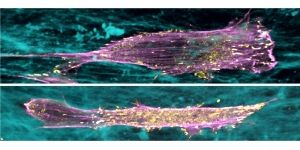Videos
HIV Replication 3D Animation
SEP 11, 2014 12:00 AM PDT
Share
Lizards Hold Clues to Growing New Human Limbs
 Would you like to be more like a lizard? Your first reaction would probably be to answer, "No." But, that could be a mistake. Lizards have the amazing ability to regenerate their tails, and that type of capability would be welcome if you ever find yourself in need of a limb. Now researchers at Arizona State University (ASU) have used advanced molecular and computer analysis tools to reveal the genes used in tail regeneration, bringing us one step closer to understanding how a similar process could help stimulate the regeneration of limbs in humans. The technique they used is to identify the genes used is called transcriptomic analysis
Would you like to be more like a lizard? Your first reaction would probably be to answer, "No." But, that could be a mistake. Lizards have the amazing ability to regenerate their tails, and that type of capability would be welcome if you ever find yourself in need of a limb. Now researchers at Arizona State University (ASU) have used advanced molecular and computer analysis tools to reveal the genes used in tail regeneration, bringing us one step closer to understanding how a similar process could help stimulate the regeneration of limbs in humans. The technique they used is to identify the genes used is called transcriptomic analysisOther animals, including salamanders, tadpoles, and fish can regenerate their tails, but you may be surprised to learn that lizards are the most closely related animals to humans with this type of regenerative ability. "Lizards basically share the same toolbox of genes as humans," said lead study author Kenro Kusumi, professor in ASU's School of Life Sciences and associate dean in the College of Liberal Arts and Sciences. "To regenerate their tails all of the animals turn on genes in what is called the "Wnt pathway." At least 326 genes are turned on over the course of a lizard's tail regeneration. 302 of these genes are also found in humans. These are the same genes involved in embryonic development, wound healing and hormone response
The scientists specifically looked at how the green anole lizard (Anolis carolinensis) goes about regenerating its tail, which it can lose when caught by a predator. They found the "genetic recipe" for its tail regeneration. Kasumi explains, "Using next-generation technologies to sequence all the genes expressed during regeneration, we have unlocked the mystery of what genes are needed to regrow the lizard tail. By following the genetic recipe for regeneration that is found in lizards, and then harnessing those same genes in human cells, it may be possible to regrow new cartilage, muscle or even spinal cord in the future."
"Regeneration is not an instant process," said Elizabeth Hutchins, a graduate student at ASU and co-author of the paper. "In fact, it takes lizards more than 60 days to regenerate a functional tail. Lizards form a complex regenerating structure with cells growing into tissues at a number of sites along the tail."
For the first 10 days, the lizard's tail heals like any other wound-new blood vessels form and epithelial tissue grows under the scab. Then the tail starts to regrow, first there's nerve tissue from the spinal cord, then soft muscle, and tissue for transporting fluids. By day 20, muscular tissue is starting to firm up around a cartilaginous tube that will eventually harden, and segment into tail bones. While functional, the new tail is not exactly the same as the original. It has a hollow cartilage tube instead of a spine, and entirely different muscle groups
While understanding the regeneration process could obviously help reproduce it in humans, it could also lead to other medical treatments, for example one to help arthritis patients. "As anyone who suffers from arthritis knows, an important part of the limb are joints, which are cushioned by a specific type of cartilage," Kusumi said in a Huffington Post interview. "Lizards grow lots of this cartilage in their regenerated tails, and we hope that this process can be activated to repair arthritis in humans." -
While new materials and new technologies such as 3D-printing have greatly improved the prosthetics available to those who have lost limbs, the ability to replace a limb with a flesh and blood copy of the one lost would, of course, be the most welcome advance of all.
You May Also Like
DEC 25, 2024
Genetics & Genomics
It's estimated that anywhere from 3 to 7% of school-age children may have dyslexia, a neruodevelopmental issue that affe
...
Written By:
Carmen Leitch
JAN 19, 2025
Clinical & Molecular DX
When cancer is detected earlier, it can improve outcomes for patients. Liquid biopsies are one way to improve cancer det
...
Written By:
Carmen Leitch
FEB 19, 2025
Genetics & Genomics
Decades ago, researchers showed that Down syndrome (also known as trisomy 21), was caused when individuals carried an ex
...
Written By:
Carmen Leitch
FEB 27, 2025
Genetics & Genomics
Scientists have now created an encyclopedia of gene function for all known human genes that code for protein. This data
...
Written By:
Carmen Leitch
MAR 03, 2025
Cell & Molecular Biology
Cooperation is common in nature. While cancer cells have been known to compete with each other for resources, it seems t
...
Written By:
Carmen Leitch
APR 11, 2025
Genetics & Genomics
Scientists have developed a novel gene editing tool that could have vast implications for research and therapeutics. Thi
...
Written By:
Carmen Leitch
Loading Comments...








